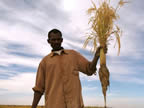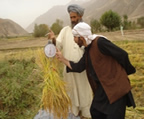SRI-Rice
at Cornell University has put together a bibliography of research articles about the System of Rice Intensification (SRI) in India. We have collected over 100 articles (nearly all from scientific journals) from India that were published
between 2004 and 2012. The chronological collection can be found on our SRI-rice website at http://sri.ciifad.cornell.edu/countries/india/research/.
Articles from India make up about a third of the 300+ SRI journal articles
we have collected from around the world. (Unfortunately, less than 30 of these
appear to be freely available to the public through the internet; the rest are
locked up in subscription sites -- though happily the abstracts are generally
available. A red dot on a title indicates the free ones so that people
won’t be frustrated by trying to open them.)
In addition to the static chronological list of Indian SRI journal articles, these items are also available in our RefWorks India research database with searchable metadata (including abstracts). (The RefWorks database site DOES have some non-journal items as well while the chronological list does not).
Worldwide Resources
In addition to the above resources on Indian research, we maintain a chronological list of SRI research from all countries as well as a searchable global database (with abstracts and other metadata). Both of these are accessible from the research section of our SRI-Rice website. (Remember to click on the “view button” to access complete metadata and the WorldCat button to find the nearest library that has the resource).
In addition to the above resources on Indian research, we maintain a chronological list of SRI research from all countries as well as a searchable global database (with abstracts and other metadata). Both of these are accessible from the research section of our SRI-Rice website. (Remember to click on the “view button” to access complete metadata and the WorldCat button to find the nearest library that has the resource).
If you know of any articles that we have missed, don't hesitate to send us note at sririceATcornell.edu... or you can add them to the comments box below.....







